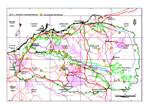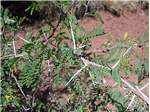Click on images
to enlarge



Photographer: B.R. Maslin

Photographer: B.R. Maslin

Photographer: J. Maslin

Photographer: B.R. Maslin

Photographer: B.R. Maslin

Photographer: B.R. Maslin

Photographer: B.R. Maslin
 1, I&E Solmon 14, lab photo by Fiona McCallum ADJUSTED_sml.jpg)
Seed from one herbarium voucher. Scale in mm. Photographer: F. McCallum.
Botanical name
Vachellia farnesiana (L.) Wight & Arnott, Prodr. Fl. Ind. Orient. 272 (1834)
Common name
Mimosa Bush, Sweet Minosa, Spiky Wattle and many more; see Kodela and Tindale (2001)
Aboriginal name
Gurarra or Goorarda (Ngarluma and Yindjibarndi), Jartinpa, Jardinda or Jartinpa (Kurrama), Jardin (Banyjima) and Jirrku or Jirruka (Nyangumarta)
Description
Brambly, often spreading, rounded or obconic, much-branched shrubs 2-4 m tall, occasionally small trees to 7 m tall. Bark dark grey, smooth or finely fissured. Branchlets reddish brown, glabrous, marked with prominent lenticels (best observed at x10 magnification or higher). Stipular spines 2-30 (-45) mm long, rigid, straight and wide-spreading. Leaves bipinnate with (1-) 2-7 pairs of pinnae; petiole 2-20 mm long, with a gland mostly at or above its middle; rachis (0.3-) 1-5.5 cm long, sometimes with a small gland at its apex, rarely with additional glands; pinnae 0.7-4 (-5) cm long; leaflets (5-) 7-15 (-23) pairs, mostly ±narrowly oblong, (2-) 4-7 (-15) mm long, 1-2.5 (-3.5) mm wide, obtuse, glabrous or besprinkled with short marginal hairs mostly near the base, green on both the upper and lower surfaces; with midrib and lateral nerves more visible and raised on lower surface. Inflorescences simple, 1-3 (-6) in axils of the leaves; peduncles (0.3-) 0.8-3 (-5.7) cm long, minutely hairy, with an involucel of bracts at apex hidden by the flowers; heads sweetly scented, globular, orange-yellow to bright golden, (33-) 40-95-flowered. Flowers 5-merous. Pods sub-terete to terete, scarcely constricted between the seeds, 1.5-8.5 cm long, 8-17 mm wide, woody, indehiscent or tardily dehiscent, curved or straight, obliquely to longitudinally finely striate, glabrous, bright dark green when young but turning dark brown to black with maturity (sutures yellow), acute. Seeds obliquely transverse in the pods, variable in shape and size, seated in pithy depressions, dull (not shiny), light to dark brown or olive-brown to olive-green; funicle rudimentary or absent.
Characteristic features
Brambly shrubs or small trees. Branchlets invested with prominent lenticels (best observed at x10 magnification or higher). Stipules spiny. Leaves bipinnate. Flower heads globular, orange-yellow to bright golden. Pods sub-terete to terete, woody, curved or straight, scarcely constricted between the seeds, obliquely to longitudinally finely striate, bright dark green when young, turning dark brown to black with maturity, glabrous. Seeds embedded in a pithy material.
Distribution and ecology
Vachellia farnesiana is a native of central America but has become widespread throughout tropical and subtropical areas of the globe where it commonly has become naturalised. According to Pedley (1980) it was collected in inland Queensland in 1845 on Coopers Creek in 1860 and must therefore have been introduced into Australia prior to or soon after European settlement (see Bean 2007 for further details). The species is widely distributed within Australia (Kodela and Tindale 2001). Vachellia farnesiana has a scattered distribution over much of the Pilbara where it grows in alluvial soils (especially clays and loams, particularly those with high calcium carbonate levels) on some open floodplains and along watercourses, often in association with A. citrinoviridis and Eucalyptus victrix. It commonly occurs as scattered individuals but it can form localized dense thickets in some areas, particularly sites that have been heavily grazed near watercourses and windmills. However, it is not a major pastoral weed like Mesquite (see below). Plants may become gnarled and untidy with age as they give in to termite invasion and attack by gall forming insects.
Flowering and fruiting period
Flowering may occur irregularly throughout the year but the main flowering flush is from June to August. Pods with mature seeds occur mostly around October and November, but may be found at other times of the year.
Taxonomy
Until recently this species had been known as Acacia farnesiana (see Seigler and Ebinger 2005 for discussion). This is the only Vachellia species found in the Pilbara region, the other eight Australian species of this cosmopolitan genus are endemic to tropical areas of the continent (Kodela and Wilson 2006). Although a number of varieties are recognized for this species within the Americas, only the typical one, var. farnesiana, appears to be represented in Australia.
Affinities
There are no close relatives of Vachellia farnesiana in the Pilbara. It is, however, related to A. (Vachellia) nilotica subsp. indica, which occurs in the Kimberley region and also in Northern Territory, Queensland (where it is declared a noxious weed) and far northeastern South Australia. Acacia nilotica has very different pods from those of V. farnesiana in that they are flattened, constricted between the seeds and densely minutely white hairy. Vachellia farnesiana has a superficial resemblance to Mesquite (Prosopis) two taxa of which (P. pallida and P. glandulosa x velutina) are pastoral weeds and Weeds of National Significance in the western Pilbara, on Mardie and Yarraloola Stations. Like V. farnesiana the species of Prosopis are spiny plants with bipinnate leaves, however, they can be recognized by their pale-coloured flowers which have only 10 stamens (flowers golden coloured and stamens very numerous in V. farnesiana, but you would need at least a x10 magnification lens to count them) and which are arranged in cylindrical spikes (not round heads as in V. farnesiana). Also, the pods of Mesquite are longer, narrower, flatter and paler coloured (yellow brown) than those of V. farnesiana. If flowers and pods are not present then V. farnesiana can be recognized by the prominent, circular lenticels that occur on its branchlets (observe at x10 magnification); in Mesquite branchlet lenticels are very obscure or absent. Also, Prosopis has a pair of spiny thorns (modified branchlets) at the base of the leaves; these thorns co-occur with a pair of tiny, non-spiny stipules. Although thorns do not occur in V. farnesiana its spiny stipules (at the base of leaves) look superficially similar to the thorns of Prosopis. However, it is the presence of both thorns and stipules that enable Prosopis to be recognized. See Perry (1998) for descriptions of Prosopis in the Pilbara.
Notes
Vachellia farnesiana has a moderate to fast growth rate but is not a particularly long-lived plant. It withstands drought but does not tolerate severe frosts.
The wood is close-grained, heavy and tough and, according to Latz (1999), has been used for making axe handles in central Australia.
Despite its spiny nature V. farnesiana is palatable and has moderate to good nutritive value. The foliage and young, green pods are eaten by cattle and sheep and are of value as a supplementary topfeed, especially in dry seasons, in Queensland (Everist 1969) and Northern Territory (Chippendale and Jephcott 1963). Although the leaves may contain low levels of cyanogenic glycoside the species is unlikely to be dangerous to stock (Maslin et al. 1987).
Under heavy grazing and around some water sources, particularly those on calcareous and heavy loamy soils, plants of this species may form and impenetrable bramble that restrict the movement of wildlife and livestock stock and is problematic during mustering.
In the Mediterranean region and north Africa plants of this species have been used extensively for hedges and windbreaks and have shown promise for erosion control. In Mediterranean countries it has also been widely cultivated for its decorative qualities and for the essential oil obtained from its flowers used for making perfume.
As reported by Juluwarlu Aboriginal Corporation (2003) and Young (2007) indigenous peoples of the Pilbara use this species for a variety of medicinal purposes, namely: the spines are poked into a wart to make it disappear; the bark is soaked in water or boiled and the liquid drunk as a cough remedy; wood (with bark removed) is burnt and the clean white ash is sprinkled over open wounds; the leaves are chewed as a cure for stomach ache and dysentery. Wood from this species was also used to make boomerangs and punishment spears (Olsson 1985). Great Sandy Desert indigenous people living at the Strelley Community boil or soak the phyllodes of V. farnesiana in water and drink the tonic to feel refreshed (McGlew and Hughes 1985). According to Latz (1999) the seed of this species is generally not eaten by traditional Aborigines of central Australia.
In the Pilbara V. farnesiana frequently provides a secure domicile for zebra finches nyimarri (Kurrama) and other small granivorous birds.
Conservation status
Not considered rare or endangered.
Origin of name
The botanical name commemorates the illustrious Italian family Farnese at whose villa near Rome this species was cultivated and from which it was originally described (Hall and Johnson 1993).
References
Bean, A.R. (2007). A new system for determining which plant species are indigenous in Australia. Australian Systematic Botany 20: 1-43.
Chippendale, G.M. and Jephcott, B.R. (1963). Topfeed. The fodder trees and shrubs of Central Australia. Extension Article No. 5. pp. 51. (Northern Territory Administration, Animal Industry Branch: Alice Springs.)
Everist, S.L. (1969). Use of fodder trees and shrubs. Advisory leaflet No. 1024. pp. 44. (Queensland Department of Primary Industries, Division of Plant Industry: Brisbane.)
Hall, N. and Johnson, L.A.S. (1993). The Names of Acacias of New South Wales with a Guide to Pronunciation of Botanical Names. pp. 69. (Royal Botanic Gardens Sydney: Sydney.)
Juluwarlu Aboriginal Corporation (2003). Wanggalili: Yindjibarndi and Ngarluma Plants. pp. 128. (Juluwarlu Aboriginal Corporation: Roebourne, Western Australia.)
Kodela, P.G. and Tindale, M.D. (2001). Acacia farnesiana. pp. 205-207. In: A.E. Orchard and A.J.G. Wilson (eds) Flora of Australia. Volume 11A. pp. 536. (ABRS/CSIRO Publishing: Australia.)
Kodela, P.G. and Wilson, P.G. (2006). New combinations in the genus Vachellia (Fabaceae: Mimosoideae) from Australia. Telopea 11(2): 233-244.
Latz, P.K. (1999). Pocket Bushtucker: a field guide to the plants of Central Australia and their traditional uses. pp. 215. (IAD Press: Alice Springs.)
Maslin, B.R., Conn, E.E. and Dunn, J.E. (1987). Cyanogenic Australian species of Acacia: a preliminary account of their toxicity potential. pp. 107-111. In: J.W. Turnbull (ed.) Australian Acacias in developing countries. Proceedings of an international workshop held at the Forestry Training Centre, Gympie, Australia, 4-7 August 1986. ACIAR Proceedings No. 16. pp. 196. (Australian Centre for International Agricultural Research: Canberra.)
McGlew, P. and Hughes, M. (1985). Aboriginal Traditional Plants - Nyangumarta. Transcript of interviews conducted at Strelley Station. (Pilbara Regional Herbarium: Karratha College, Karratha.)
Olsson, C. (1985). Some of the Traditional Plant Resources of the Ngarluma and Yindjibarndi Tribes of the Pilbara Region of Western Australia. Unpublished manuscript. (Pilbara Regional Herbarium: Karratha College, Karratha.)
Pedley, L. (1979). A revision of Acacia Mill. in Queensland (concluded). Austrobaileya 1(3): 235-337.
Perry, G. (1998). Prosopis. pp. 7-11. In: A.E. Orchard and P.M. McCarthy (eds) Flora of Australia. Volume 12. pp. 213. (ABRS/CSIRO Publishing: Australia.)
Seigler, D.S. and Ebinger, J.E. (2005). New combinations in the genus Vachellia (Fabaceae: Mimosoideae) from the New World. Phytologia 87(3): 139-178.
Young, L. (2007). Lola Young: Medicine Woman and Teacher. Complied by Anna Vitenbergs. pp. 160. (Fremantle Arts Centre Press: Fremantle.)
